Oil Heat 101: A Beginner’s Guide to Understanding, Operating and Maintaining Your Oil-Fired Furnace
A Comprehensive Guide for Keeping Your Home Warm All Winter Long
Welcome to “A Beginner’s Guide to Understanding, Operating and Maintaining Your Oil-Fired Furnace“!
This guide is designed for homeowners and beginners who want to understand how an oil-fired furnace works, how to operate and maintain it properly, and how to troubleshoot common problems. Whether you are considering buying a new oil-fired furnace or already have one in your home, this guide will provide you with the knowledge and skills you need to ensure that your furnace runs efficiently and safely. From understanding the different types of oil-fired furnaces and how they work to learning how to perform routine maintenance and troubleshoot common issues, this guide is a comprehensive resource for anyone who wants to understand and care for their oil-fired furnace.
We will provide an overview of how to operate your oil-fired furnace properly, learn about safety precautions to take when operating your furnace and how to shut it down in the event of an emergency properly.
Finally, the guide will provide detailed instructions on performing routine maintenance on your oil-fired furnace, including cleaning and replacing filters, checking and replacing the oil, and troubleshooting common problems that may arise. You will also learn about the signs that indicate it’s time to call a professional for service and maintenance. This guide will help ensure that your oil-fired furnace runs safely and efficiently for many years.
How to Choose the Right Heating Oil Furnace
Residential heating oil furnaces are an efficient and reliable way to heat your home. The proper maintenance and upgrades can save you money on your energy bills while reducing your carbon footprint. The Federal Energy Management Program (FEMP) provides resources and guidance to help homeowners make the most of their heating oil furnaces.
When choosing a heating oil furnace, there are several factors to consider. The size of the furnace should be based on the square footage of the home or building. The efficiency rating of the furnace, measured by the Annual Fuel Utilization Efficiency (AFUE), should also be considered. The higher the AFUE rating, the more efficient the furnace is. Other features include programmable thermostats, high-performance filters, and self-diagnostic systems.
One way to increase the efficiency of your heating oil furnace is to upgrade to a newer, more efficient model. According to FEMP, modern heating oil furnaces can have an Annual Fuel Utilization Efficiency (AFUE) rating of up to 95%, which means that 95% of the fuel used by the furnace is converted into heat for your home. This is significantly higher than older furnace models, which may only have an AFUE rating of 60-70%.
When selecting a contractor to install the furnace, it’s essential to choose someone who is licensed, insured, and has a good reputation in the community. Ask for references and check online reviews before making a decision.
Additionally, FEMP suggests using a programmable thermostat, which allows you to s
How to Operate Your Heating Oil Furnace
Operating an oil furnace can initially seem intimidating, but with some knowledge and understanding, it’s pretty simple. Here’s a step-by-step guide to help you confidently operate your oil furnace.
Step 1: Familiarize yourself with the furnace’s controls. Most oil furnaces have a thermostat, an on/off switch and a switch for the fan. Make sure you know where these controls are located and how they work.
Step 2: Check the oil level. Before turning on the furnace, ensure enough oil is in the tank. If the oil level is low, you need to call a professional to refill it.
Step 3: Turn the thermostat to the desired temperature. This will signal to the furnace that it needs to turn on.
Step 4: Turn on the furnace by switching the on/off switch to the “on” position. You should hear the furnace start up and circulate warm air throughout your home.
Step 5: Adjust the fan speed. Most oil furnaces have a switch that allows you to control the fan’s speed. A slower fan speed will circulate the warm air more slowly, while a higher speed will circulate it more quickly.
Step 6: Monitor the furnace’s operation. Check the thermostat to ensure the temperature stays at your desired setting. Listen for any strange noises or smells coming from the furnace. If you notice anything unusual, turn off the furnace and call a professional.
Step 7: Turn off the furnace. When you are done using the furnace, turn off the switch to the “off” position.
You’ll need to familiarize yourself with your oil heating system basics.
First, you must determine whether you have an oil furnace or a boiler.
How does your oil furnace work?
An oil furnace is a device that burns oil to heat air. 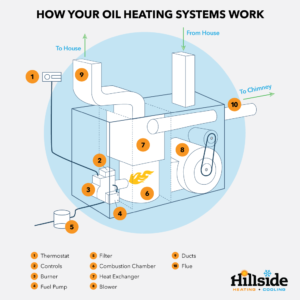
(A) The thermostat sends a signal to the controls on the burner.
(B) The fuel pump draws oil through a filter to the burner.
(C) The burner turns the oil into a fine spray, mixes it with air, and ignites it in the combustion chamber, causing the chamber to become very hot.
(D) Air absorbs heat in the heat exchanger.
(E) A blower sends this air through ducts to heat the home.
(F) The air eventually circulates back to the heat exchanger, and the cycle continues. (G) Combustion emissions are vented out the flue.
H) Hillside Oil Heating & Cooling is a full-service heating oil company. We deliver fuel to your home and can install, maintain, and repair oil (and natural gas, propane gas, and electric) heating systems in DE, MD, & PA.
Another type of oil heating system is a boiler. Instead of air, boilers heat up, circulating water pumped through pipes to radiators. Some oil heat systems also heat hot water.
How to Check Your Oil Levels
Checking your heating oil levels may seem daunting, but it’s pretty simple. By regularly monitoring your oil levels, you can ensure that your furnace never runs out of fuel and that you never have to pay for an emergency delivery.
Here’s a step-by-step guide to help you check your heating oil levels:
Step 1: Locate the oil tank. Your heating oil tank is typically located in the basement, garage, or outside your home. It will be a large, cylindrical tank with a gauge or dipstick on the side.
Step 2: Check the gauge or dipstick. Most tanks will have a gauge or dipstick that you can use to check the oil level. The meter will typically have a dial or a sliding indicator that shows the current oil level. The dipstick will have a marker or a line that indicates the oil level.
Step 3: Read the gauge or dipstick. Depending on the type of gauge or dipstick, you may need to read it in a specific way. For example, some meters have a dial showing the tank’s percentage of oil. In contrast, others have a sliding indicator that indicates the number of inches of oil in the tank. If you’re using a dipstick, you’ll need to remove it from the tank and wipe it clean before checking the oil level. The marker or line on the dipstick will indicate the oil level.
Step 4: Record the oil level. Once you’ve read the gauge or dipstick, note the oil level. You’ll want to check the oil level every few weeks to ensure you’re not running low on fuel.
Step 5: Order more oil if necessary. If the oil level is getting low, it’s time to order more. You can call your oil supplier and place an order for more fuel. Most suppliers will deliver the oil to your home and take care of your installation.
It would help if you only attempted to check or fill your heating oil tank with assistance. Oil tanks can be dangerous and should always be handled by a professional. In addition, as part of the safety protocol, you should always check for leaks or any signs of damage before checking the oil level. If you notice any leaks or damage, call a professional immediately.
By following these simple steps, you can ensure that your heating oil tank is always full and that your furnace never runs out of fuel. It’s a small step that can save you a lot of hassle and money in the long run.
You CAN run out of heating oil.
If you are coming from electric or natural gas heat, those are two sources that do not “run out.” However, the heating oil in your oil tank can and will run out if not replenished regularly. Consider automatic delivery to ensure this never happens, and you go without heat or cause damage to your heating system.
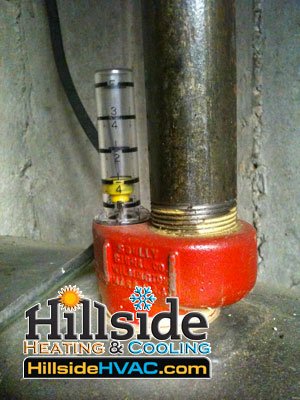
Tanks should never be empty. If your tank is less than a quarter full, you should order more oil as soon as possible. Running out of heating oil is worse than running out of gasoline in your car.
There are several ways to measure how much oil is in the tank. If you have an oil gauge, you need to read it, but if you don’t, you can use a dipstick or a rod to find out how many inches of oil you have, then consult a tank chart.
Remember: it’s best to be conservative and order your heating oil early rather than ordering in a no-heat emergency. What is the best way to manage this risk? Sign up for FREE Automatic Delivery and let Hillside Oil Heating and Cooling worry about managing your heating oil.
Ordering Your Fuel (Heating Oil)
Full-Service Home Heating Oil Provider In DE, PA, & MD.
Our services include heating oil delivery, repair, and maintenance. Hillside provides both automatic delivery and call-in delivery services. We deliver home heating oil regardless of the weather. Our fleet of state-of-the-art vehicles ensures reliable deliveries.
Your Local Heating Oil Company:
We are grateful to have a team of local residents who understand what you need and the importance of getting it right. We understand your home comfort needs better than an oil company run by some far-off parent corporation. Our customer service agents are real people—not soulless call center automatons who don’t care about helping you out.
OUR HEATING OIL DELIVERY OPTIONS
For customers who never want to worry about the fuel level in their tank, automatic delivery is available.
Hillside Oil uses a mathematical formula to determine when its customers’ oil tanks need refilling. The formula uses accumulated data from previous deliveries and local weather conditions to predict when future deliveries will be made. New accounts are based on a specific type of home similar to yours. The homeowner should cooperate with the scheduling of the first delivery. Heating oil deliveries may be made only if there is no outstanding balance on your account and no unsafe conditions related to filling, venting or tank problems exist at that time.
Would you like to know how automatic deliveries are calculated?
The degree-day system is the standard for calculating when deliveries are made in the industry. This link, www.weatherdatadepot.com, will help you understand how the degree-day system works and track your personal fuel oil consumption by comparing seasons from past years to see if you may need deliveries sooner than usual this winter.
Sign Up Today for Automatic Heating Oil Delivery
Our free automatic delivery program is one way we help our customers get the most out of their heating oil. By scheduling deliveries in advance, we can ensure your house has what it needs when you need it—which helps us deliver on-time daily deliveries. Now you can enjoy hassle-free heating oil delivery service in Cecil County, MD, New Castle County. DE and Southern Chester County PA with Hillside Oil Heating & Cooling’s Automatic Delivery Plan
Call Hillside Heating and Cooling today at 302-738-4144 (DE & PA) or 410-398-5879 (MD), or contact us to sign up for Automatic Heating Oil Delivery!
CALL-IN or WILL-CALL DELIVERY
Call-in delivery allows customers to monitor and purchase fuel oil at a time of their choosing. This is helpful for those who want more control over their spending on the product. To schedule a delivery, call our office. We will arrange for pickup based on availability in your area and the normal pickup time is Monday-Friday between 7:00 am – 5:00 pm.*Prices are subject to change depending upon market price.
Call Hillside Heating and Cooling today at 302-738-4144 (DE & PA) or 410-398-5879 (MD) or call us to schedule your Home Heating Oil Delivery!
ONE PRICE FOR FUEL OIL
We do not offer different programs or levels of customer service. We treat all our customers equally, and everyone receives the same price. Our COD price is available by paying at the time of delivery. Hillside’s credit billing customers receive ten days to get an additional 5 cents per gallon off. Many companies will charge extra for the service of automatic delivery. The truth is that an automatic delivery customer saves an oil company money. The oil company can deliver at the company’s convenience. A customer should pay less for this service, as it is convenient for both customer and the company. Hillside Heating & Cooling feels that different levels of plans, tiers, or customer service groups are not fair to any customer. When too many options are available, things can get confusing. Hillside believes that if you are our customer, we will do anything to help.
Choosing Hillside as your provider is a compliment to the company. However, we cannot force someone to use our services. We are glad you choose Hillside, but we also understand if you move on. Many companies charge account termination fees, but Hillside does not practice these methods.
We Operate A Fleet Of Modern, Clean, And Well-Maintained Vehicles.
Reliable equipment allows Hillside to show up on time and provide prompt and efficient service. Routine equipment maintenance and safety training for our drivers help Hillside eliminate damage to your home or property. Safety is our primary concern for our customers, equipment, and Hillside’s employees. Keeping safety as a primary concern allows Hillside to offer the best price for services possible. Safety keeps insurance and other expense to Hillside down, thus allowing us to provide the best prices possible. We treat our customers with respect, and part of that is to arrive presentable to the public.
Premium Heating Oil Additive For Reliable Protection Against Winter Freezing, Sludge, And Contamination.
We care about your heating system’s health during the coldest days of winter and wish to extend the life of your fuel tank. Therefore, Hillside has begun treating our heating oil with a premium additive at no cost to our customers.
The unique heating oil treatment inhibits microbial growth, dissolves sludge, improves combustion, avoids breakdowns from clogged lines, strainers, and nozzles, disperses water accumulation, minimizes corrosion, and prevents winter freeze-ups. This results in maximum energy output, fewer service calls, and increased savings.
We offer a proactive annual TANK-GUARD® Oil Tank Program and Heating Maintenance Plans for additional protection.
Budget Billing
A monthly budget plan is an effective way to avoid large peak-season bills. Monthly budget payments allow customers to spread their heating expenses throughout the year. The calculation of a customer’s monthly budget is straightforward. Hillside uses estimated annual expenditures and divides that amount into equal monthly payments. The budget amount may be adjusted up or down as many times as needed throughout the season, depending on price and weather.
SIGN UP FOR OUR BUDGET PLAN FOR HEATING OIL
- Monthly payments instead of large peak-season bills
- Automatically charge a checking account or credit card so your payment is never overlooked
Hillside offers a convenient monthly budget payment plan. Hillside’s program is simple; we estimate your total annual expenditures with our company and divide that among 12 monthly payments. We start our budget year in the summer, so that money paid during the summer allows you to build up credit that will be used when deliveries are made in the fall and winter. Your budget is based on the average number of gallons you use per year multiplied by an estimated average fuel price for the upcoming season. If you have any of our maintenance plans, we factor those into your monthly payment amount.
If you are interested in our heating oil budget plan or have questions about the FREE program, please contact our office at 302-738-4144 or 410-398-2146 Monday thru Friday from 9 am-3 pm, or contact us.
If you want more detailed information or to sign up for our plan, here are the budget sign-up form links.
How to Check for Oil Leaks
Knowing how to spot a heating oil leak and what to do if you find one is essential as a homeowner. A heating oil leak can be a severe problem, not only because of the potential environmental damage but also because it can be a fire hazard. Here’s a guide on how to spot a heating oil leak and what steps to take if you find one.
Step 1: Watch for signs of a leak. Some common signs of a heating oil leak include a strong odor of oil, discoloration or staining on the ground near the tank, and an unexplained decrease in the oil level in the tank. If you notice any of these signs, you must take action immediately.
Step 2: Check for leaks. If you suspect a leak, it’s essential to check for leaks in the tank, the fill pipe, and the oil lines. Also, look for any signs of damage, such as holes, cracks, or loose fittings. If you find a leak, turn off the oil supply to the tank immediately.
Step 3: Call a professional. If you find a leak, you must call a professional immediately. A professional can repair the leak and ensure the tank is sealed correctly. Hillside Oil Heating & Cooling: Call Our office at 302-738-4144 (DE & PA) or 410-398-5879 (MD) or contact us.
What to Do if You Discover A Heating Oil Leak
If you suspect a heating oil leak, taking action immediately is vital. A leak can be a severe problem, not only because of the potential environmental damage but also because it can be a fire hazard. However, following these steps can help keep your home and community safe. And always remember, if in doubt, feel free to call a professional.
- Turn off the oil supply: The first step is to turn off the oil supply to the tank to stop the leak. This can be done by turning off the valve controlling the oil flow to the tank.
- Evacuate the area: If there is a significant amount of oil spilled, it’s important to evacuate the area to avoid breathing in the fumes. This can be especially dangerous if the leak is in a confined space such as a basement.
- Call for professional help: It’s essential to call a professional as soon as possible. A professional can repair the leak and ensure the tank is sealed correctly. They will also be able to advise on the best way to clean up the spill and safely dispose of the contaminated materials. Hillside Oil Heating & Cooling: Call Our office at 302-738-4144 (D.E. & P.A.) or 410-398-5879 (M.D.) or contact us.
- Report the leak: Once it has been repaired, it’s essential to report it to your local fire department and the National Response Center. This will help prevent any further damage and will help keep your community safe.
- Clean up the spill: If there is a significant amount of oil spilled, you will need to clean it up as soon as possible. You can use absorbent materials, such as kitty litter or oil-absorbent pads, to soak up the oil. Once most of the oil has been absorbed, you can use soap and water to clean the area.
Emergency Contact Numbers:
Delaware: Report the spill to Delaware’s 24-hour spills hotline at 1-800-662-8802. Verizon Wireless customers should dial #367.
Pennsylvania: Report the spill to the Southeast Regional Office 24-hour spills hotline at 484 250-5900.
M
Cleanup: Containment and Removal of the Spill
Cleaning up a heating oil leak can be a complex process that trained professionals should handle. The specific steps in cleaning up a heating oil leak will depend on the leak’s severity and location. However, here are some general guidelines for cleaning up a heating oil leak:
- Containment: The first step in cleaning up a heating oil leak is to contain the spill to prevent it from spreading. This may involve installing booms or other barriers around the spill to keep the oil from spreading further.
- Absorption: Once the spill has been contained, absorbent materials such as cat litter, oil-absorbent pads, or boom can be used to soak up the oil. These materials can be spread over the spill and then removed for disposal.
- Recovery: After the oil has been absorbed, it must be recovered from the absorbent materials. This can be done using vacuum trucks or other specialized equipment.
- Treatment: After the oil has been recovered, it will need to be treated to remove any remaining contaminants. This may involve using chemicals or other types of treatment to break down the oil and remove any remaining pollutants.
- Disposal: Once the oil has been treated, it must be disposed of properly. This may involve sending it to a refinery or waste-to-energy facility for processing, or it may need to be sent to a hazardous waste facility for disposal.
- Restoration: The site must be restored to its original condition after cleaning it. This may involve replacing soil, planting vegetation, and taking other steps to correct the environment.
It’s important to note that different states have different regulations and requirements for cleaning up a heating oil leak, and it’s crucial to follow the specific guidelines established by your state. It’s also essential to consult with a professional, as they can advise on the best course of action and ensure that the cleanup is done correctly and safely.
Hillside Oil Heating & Cooling: Call Our office at 302-738-4144 (DE & PA) or 410-398-5879 (MD) or contact us.
If you have an emergency, call Hillside at 302-738-4144 or 410-398-2146
How to Prevent Heating Oil Leaks
Preventing oil leaks is essential to maintaining your heating system and keeping your home safe. Here are a few steps you can take to prevent oil leaks and keep your system running smoothly:
Step 1: Schedule regular maintenance. The best way to prevent oil leaks is to schedule regular maintenance for your heating system. A technician can check for potential leaks and make necessary repairs to keep your system running safely.
Step 2: Check for leaks regularly. In between maintenance appointments, it’s a good idea to check your system for leaks regularly. Look for any signs of oil on the ground near your tank or any unusual smells or sounds coming from your furnace. If you notice any symptoms of a leak, call a professional immediately.
Step 3: Replace old or damaged parts. Over time, parts of your heating system can become worn or damaged, leading to leaks. If your technician finds any old or damaged parts, it’s essential to have them replaced as soon as possible to prevent leaks.
Step 4: Keep your tank level. Make sure to keep your oil tank level stable. An unlevel tank can cause stress on the tank and its fittings, which can lead to leaks. Call a professional to fix the issue if your tank is becoming unlevel.
Step 5: Insulate your oil lines. Insulating your oil lines can help prevent leaks by keeping the oil from freezing during winter. This can be a cost-effective solution and can save you money in the long run.
Step 6: Get your tank inspected. Have your tank inspected by a professional to check for any signs of corrosion or damage. This can help you identify potential leaks before they become a problem.
These steps can help prevent oil leaks and keep your heating system running safely and efficiently. Regular maintenance and inspections are the keys to preventing leaks and keeping your home safe. If you have any doubts or concerns about your heating system, don’t hesitate to call a professional for assistance.
Hillside Oil Heating & Cooling: Call Our office at 302-738-4144 (DE & PA) or 410-398-5879 (MD) or contact us for Heating Oil Maintenance.
How to use a basic thermostat and a smart thermostat for my heating oil tank
A thermostat is essential in controlling the temperature in your home, and it’s important to know how to use it properly. Here’s a guide on using both a basic and smart thermostat for your heating oil tank.
Using a Basic Thermostat:
Step 1: Locate the thermostat. Your thermostat will typically be located on a wall near the entrance of your home. It will have a simple display and a set of buttons.
Step 2: Adjust the temperature. Use the buttons on the thermostat to adjust the temperature to your desired setting.
Step 3: Check the current temperature. The thermostat will display the current temperature in your home.
Step 4: Adjust the fan speed. Most thermostats have a switch that allows you to control the fan’s speed. A slower fan speed will circulate the warm air more slowly, while a higher speed will circulate it more quickly.
Step 5: Monitor the furnace’s operation. Check the thermostat to ensure the temperature stays at your desired setting. Call a professional for assistance if you notice any issues, such as the furnace not turning on or heating correctly.
Using a Smart Thermostat:
Step 1: Install the thermostat. Smart thermostats like Google Nest, Emerson, Eecobee, or Honeywell.
Step 2: Connect the thermostat to your home’s Wi-Fi network. Follow the instructions provided with the thermostat to connect it to your network.
Step 3: Download the app. Most smart thermostats have an app you can download to your smartphone or tablet.
Step 4: Set the temperature. Use the app to set the temperature to your desired setting. You can also use the app to schedule when the temperature should change.
Step 5: Monitor and control the temperature remotely. With a smart thermostat, you can remotely monitor and control the temperature in your home using your smartphone or tablet.
Step 6: Use energy-saving features. Smart thermostats often have energy-saving features such as learning your schedule and automatically adjusting the temperature to optimize energy consumption.
Both basic and smart thermostats are essential tools to keep your home comfortable. Still, smart thermostats offer more flexibility and convenience, allowing you to control and monitor your heating oil tank remotely using your smartphone or tablet and also save energy by using its features. Always consult a professional if you have doubts or concerns about your heating system or thermostat.
Hillside Oil Heating & Cooling: Call Our office at 302-738-4144 (DE & PA) or 410-398-5879 (MD) or contact us for Thermostat Installation.
The Importance of Furnace Maintenance
Heating oil furnace maintenance is essential to keeping your home warm and comfortable, and it’s crucial to stay on top of regular maintenance to ensure that your furnace runs efficiently and safely. According to the U.S. Department of Energy (DOE), regular maintenance can help extend your furnace’s life, improve efficiency, and reduce the risk of breakdowns and costly repairs.
A critical aspect of heating oil furnace maintenance is an annual tune-up. During a tune-up, a certified and trained HVAC technician inspects and cleans your furnace, checking for potential problems and making necessary repairs. This helps ensure that your furnace is running at peak efficiency and helps to prevent breakdowns and costly repairs down the road.
Another critical maintenance aspect is regularly changing the oil filter, air filter, and nozzle. These parts can become clogged with debris, which can reduce the efficiency of your furnace and lead to increased maintenance costs. According to the DOE, changing the oil filter every year and the air filter every three months is recommended.
Additionally, keep an eye on your oil levels and ensure you never run out of fuel. Running out of power can cause damage to your furnace, and it’s essential to keep an eye on your oil levels to ensure that you always have enough fuel to keep your furnace running.
Finally, it’s essential to have your furnace inspected for leaks, corrosion, or any signs of damage. A leaking furnace can be a severe problem, not only because of the potential environmental damage but also because it can be a fire hazard.
Regular maintenance is essential to keeping your heating oil furnace running efficiently and safely. According to the U.S. Department of Energy, regular tune-ups, regularly changing the oil filter, air filter, and nozzle, monitoring the oil levels, and having the furnace inspected for leaks, corrosion, or any signs of damage, are crucial to preventing breakdowns and costly repairs in the future. In addition, by staying on top of regular maintenance, you can keep your home warm and comfortable and save money on energy costs in the long run.
If you have an emergency, call Hillside at 302-738-4144 or 410-398-2146
Hillside’s Heating Maintenance Plan
At Hillside, We service all major brands of furnaces, including boilers.
Regular furnace cleaning and maintenance help prevent frequent failures, inefficient performance, and poor indoor air quality. Hillside Heating & Cooling is the leading furnace cleaning and maintenance specialist in New Castle County, DE, Cecil County, MD, and Southern Chester County, PA. Schedule our 30-point Furnace Tune-Up designed to prevent heating problems this season.
Heater Tune-Up Includes the Following:
- Replace nozzle one oil filter, and pump strainer
- Clean, lubricate, and adjust burner, inspect all controls and adjust if needed
- Vacuum and clean the boiler or furnace, smoke pipe, and base of the chimney (Where needed and accessible)
- Inspect and clean combustion chamber – Oil circulating pump or fan motor and bearings
- Clean and adjust electrode and high-tension leads
- Check the pump, examine belts, pulleys, and couplings
Warm Air Systems:
Percentage of coverage based on the plan for parts and labor associated with repairs or replacements of defective parts (as listed below) due to normal wear and tear for one year from the date of acceptance. Parts not explicitly listed are not covered. Suppose replacement of equipment becomes necessary or the customer decides to upgrade. In that case, Hillside will credit the amount of this maintenance plan toward a replacement performed by Hillside. The customer must call and schedule an annual tune-up to keep the furnace operating.
- Electrodes Nozzle
- Pump strainer
- Fan & limit control
- High tension lead
- Oil burner motor
- Draft regulator
- Combustion Chamber
- 1 Thermostat (Plain)
- Drive Couplings
- Smoke pipe-10’
- Shaft/bearings
- Transformer
- Fuel oil pump
- Fuel oil filter
- Primary relay
- Burner fan
- Blower motor
- Blower belt
Hot Water (Boiler) Systems:
All parts covered in warm air system plus: Feed Valve, Relief Valve, Aquastat, Circulator Motor, Drive & Bearing Assembly. An extra $20.00 is charged for each additional circulator.
Call Hillside Heating and Cooling today for furnace maintenance plans, furnace repairs, or a FREE estimate for new furnace sales and installation in DE, PA, and MD at 302-738-4144 or 410-398-2146 or contact us to schedule service.
If you have an emergency, call Hillside at 302-738-4144 or 410-398-2146
WHAT TO DO WHEN YOUR OIL FURNACE HAS NO HEAT
No heat checklist on your oil fired furnace.
1. Check your thermostat.
Make sure your thermostat is set to heat and set high enough to call for heat, meaning the desired temperature is higher than the room temperature. Also, make sure if your thermostat requires batteries, the batteries are good.
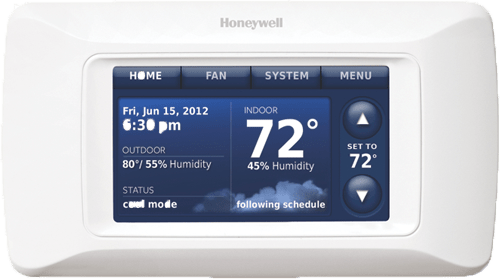
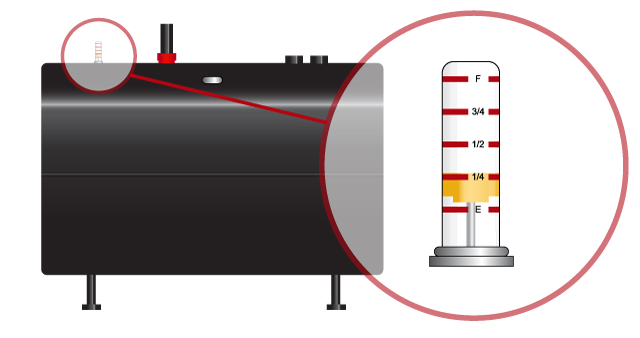
2. Make sure you have oil in your tank.
Locate your tank: Your oil tank is more than likely in the basement or outside the house, relatively close. It’s a giant metal tank. Do you know how to read your oil tank gauge?
Find the fuel gauge: Your oil gauge is a clear tube with a float inside and will be located on top of the oil tank. A standard residential oil tank holds 275 gallons. Based on that size, the following readings indicate how many gallons of oil your tank contains. The float goes up and down according to how much fuel is in the tank:
- F (full) = 275 gallons
- 3/4 = 200 gallons
- 1/2 = 130 gallons
- 1/4 = 70 gallons
- 1/8 = 40 gallons
- E (empty) = near empty
Reading your gauge is like reading the gas gauge in your car. If the float is not visible at the bottom of the tube, then the tank is empty or close to empty. See Hillside’s Tank Chart.
Do NOT always trust your gauge; they can be finicky. You will need a straight stick to manually check your heating oil level in an oil tank.
Remember: We recommend ordering heating oil when your tank is one-quarter full rather than ordering in a no-heat emergency. Sign up for our Worry-Free Winter, and we’ll manage everything for you.
3. Locate the emergency shutoff switch. 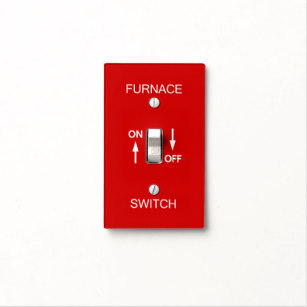
Usually, the emergency shutoff switch is located near the basement steps and/or next to your heating system. Make sure the switch is in the “ON” position. These switches look just like light switches and accidentally get turned off if you have guests. This happens more frequently than you might think.
4. Check your power source.
Locate and open your electrical panel. It’s usually found in the basement or a utility room. Check for and fix any blown fuses or tripped circuit breakers. Sometimes our furnace technicians “repair” the furnace by simply making sure your furnace is getting power.
5. Reset your system.
Sometimes a simple system reset is all that’s needed. Locate your heating system’s burner, press the reset button ONCE (and only ONCE), and listen for the system to start up. If you had to open the door to access your furnace, be sure to close that door after pressing the reset button.
When to Get Your Oil-Fired Furnace Repaired
Oil-fired furnaces are a standard heating system for many homes. Still, like any mechanical system, they can malfunction and require repairs. Therefore, it is crucial to know when to call for a repair to keep your furnace running efficiently and avoid costly breakdowns.
This chapter will discuss some signs indicating it is time to repair your oil-fired furnace.
- Reduced heating capacity: If your furnace is not producing enough heat, it may be a sign that there is a problem with the burner or the fuel delivery system. A clogged fuel filter or a malfunctioning nozzle could cause this. A professional technician will be able to diagnose and repair the issue.
- Strange noises: If your furnace is making strange noises, such as banging, popping, or whistling, it could be a sign that there is a problem with the burners, the blower, or the ductwork. A technician can identify the noise source and make the necessary repairs.
- Soot buildup: If you notice soot buildup around the furnace or on the walls and ceilings, it could indicate a problem with the burners or the chimney. Soot buildup can also signify a carbon monoxide leak, a severe safety hazard. A professional technician will be able to diagnose and repair the issue.
- Frequent cycling: If your furnace is turning on and off frequently, it could be a sign that there is a problem with the thermostat or the limit switch. A technician will be able to diagnose and repair the issue.
- Yellow flame: If the flame in your furnace is yellow instead of blue, it could indicate a problem with the burners or the fuel delivery system. A yellow flame can also signify a carbon monoxide leak, a severe safety hazard. A professional technician will be able to diagnose and repair the issue.
It is essential to have your oil-fired furnace inspected and serviced annually to keep it running efficiently and safely. Call a technician for repairs if you notice any of the signs above or if your furnace is not working correctly. Ignoring these issues can lead to costly breakdowns and can also be dangerous.
Suppose you notice reduced heating capacity, strange noises, soot buildup, frequent cycling, or yellow flame. In that case, it’s time to call a professional technician to repair your oil-fired furnace. Also, remember to have your furnace inspected and serviced annually to prevent any issues.
HONEST FURNACE REPAIR SERVICES
When you schedule a furnace repair service from Hillside Heating Oil & Cooling, we’ll thoroughly inspect and accurately determine why your furnace stopped working. Then, before we begin any furnace repair, our honest HVAC techs will explain why your furnace has stopped working, go over your options, and let you decide how to proceed with no pressure.
All furnace repairs include:
- A call from your technician before arrival so you’ll know just when to expect us
- Diagnostic and safety check of your equipment
- Fixed price quote including all parts and labor required – no hidden charges
Call Today If Your Furnace Has Stopped Working.
If your house is cold and your heater has stopped working, our furnace repair technicians can fix it. We’ve been successfully repairing furnaces for over 70 years. Hillside’s HVAC technicians have the training, certifications, and knowledge to repair all major furnace brands.
Before you call, it may be a simple fix that you can do. But first, check out our “No Heat Checklist” on your oil-fired furnace.
If you have a furnace emergency, call Hillside Heating and Cooling today at 302-738-4144 (DE & PA) or 410-398-2146. (MD) or contact us to schedule service (some furnaces even qualify for local rebates). Hillside offers furnace maintenance, repairs, and FREE estimates for new furnace sales and installation in DE, PA, and MD.
When to Replace Your Furnace
As a homeowner, it’s crucial to stay on top of the maintenance and upkeep of your home, including your furnace. But how do you know when it’s time to replace your furnace? Here are a few signs to look out for:
First and foremost, pay attention to the age of your furnace. Most furnaces have a lifespan of around 15-20 years. If your furnace is approaching or has surpassed this age, it may be time to consider a replacement.
Another key indicator is the efficiency of your furnace. Suppose your energy bills have been steadily increasing, despite no changes in usage. In that case, it may indicate that your furnace is not running as efficiently as it should. A newer, more efficient furnace could save you money in the long run.
In addition to age and efficiency, pay attention to any strange noises or smells from your furnace. For example, suppose you notice banging, squealing, or other unusual sounds. In that case, it could signify a problem with your furnace’s internal workings. Similarly, suppose you smell gas or burning. In that case, it’s essential to turn off your furnace immediately and call a professional to inspect it.
Finally, consider a replacement if you’ve been calling for repairs more frequently. Frequent repairs can be costly, and a new furnace may be a more cost-effective solution in the long run.
If you’re experiencing any of these issues with your furnace, it’s a good idea to consult a professional to determine if it’s time for a replacement. Remember, a well-maintained furnace can help keep your home warm and comfortable while also saving you money on energy costs.
If you have a furnace emergency, call Hillside Heating and Cooling today at 302-738-4144 (DE & PA) or 410-398-2146. (MD) or contact us to schedule service (some furnaces even qualify for local rebates). Hillside offers furnace maintenance, repairs, and FREE estimates for new furnace sales and installation in DE, PA, and MD.
Hillside Oil Heating
Hello, and thank you for reading our guide from your trusted provider of full-service heating, oil, and cooling services. Hillside Heating and Cooling are a well-respected, locally-owned, and operated company with a reputation for providing top-quality service and unparalleled expertise.
At Hillside, we understand that your home’s heating and cooling systems are essential to your comfort and safety. That’s why we offer a wide range of services to keep your systems running at peak efficiency. From routine maintenance and repairs to complete system replacements, we have the expertise and experience to handle any HVAC needs.
We specialize in oil-fired furnace service and repair, as well as air conditioning maintenance and repair. Our certified technicians are equipped with the latest tools and technology to diagnose and repair any issues quickly and efficiently. We also offer a comprehensive maintenance program to keep your systems running at peak efficiency and to prevent breakdowns.
In addition to our exceptional service, we also offer competitive pricing and financing options to make it easy and affordable for you to keep your home comfortable.
Hillside Oil Heating & Cooling has been family-owned and operated for over 70 years servicing New Castle County, DE, Cecil County, MD, and Southern Chester County, PA. Three generations of family attitudes and values have allowed us to serve our customers and communities successfully. Everything about Hillside is locally owned and operated. We do not answer to any parent or mother corporation in some far-off land. Real human beings still work here and answer our phones. We have no touch-tone mazes to navigate to speak to a human who can assist or answer questions. Customer service is the most important thing. We know what it is like to be a customer and how we like to be treated. We take pride in thinking like a customer when dealing with our customers.
Support of Hillside is for the local, homegrown, family business in our area. Thank you from everyone at Hillside for your business.
If you have an emergency, call Hillside at 302-738-4144 or 410-398-2146
The Hillside Maintenance Plans
Keeping Your Paws Comfy All Year Round
The Hillside Maintenance Plans are designed to prevent minor problems from turning into major issues! Extend the life of your equipment, reduce the need for costly repairs, and increase the performance of your heating and cooling systems while lowering your utility bills.



